L’Épée 1839, which MB&F quite justifiably touts as “Switzerland’s premier clockmaker,” loves working with the creative team and “friends” at MB&F (which stands for “Max Büsser & Friends”). In fact, they enjoy working together so much that they have just released their thirteenth joint clock. And it won’t be the last: TriPod is the second clock in a planned series of three that began in 2019 with the T-Rex.
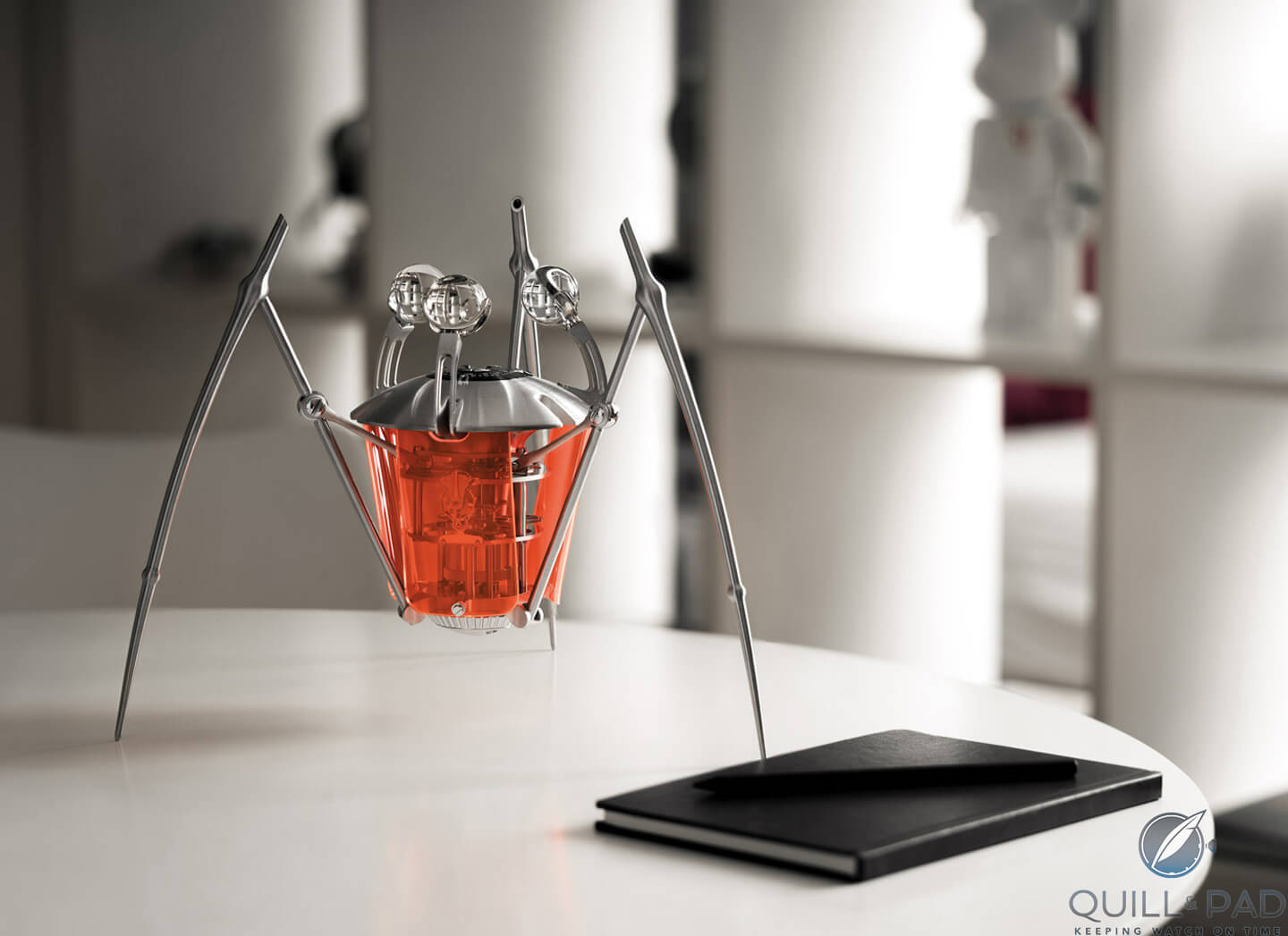
MB&F + L’Épée 1839 TriPod Red
TriPod tells the time in hours and minutes but, as one might expect from MB&F, not in the usual way. The dial is designed to be read from any angle or direction by indicating the hours and minutes three times; the concentric dials show 36 hours (1-12 repeated three times) instead of the usual 1-12. I’ll explain why below.
This minimalist time display is surrounded by something extraordinary: a framework of plated brass, optical mineral glass, and fluorescent acrylic shields all designed to resemble an insect.
After a dinosaur, why an insect?
TriPod was inspired and designed by 31-year-old Berlin-based designer Maximilian Maertens. His work on this timepiece was characterized by two important events in his life: the first, upon finishing his master’s in design at ECAL in Lausanne Maertens interned at MB&F where he worked on T-Rex, was preceded by deep memories of being impressed by the 1993 cinematic spectacle Jurassic Park.
One of MB&F’s taglines is “a creative adult is a child who survived.” Right up front on the brand’s homepage, listed under “what we stand for,” it reads: “. . . recognizing the universal imagination of children before they are formatted into their rational, reasonable adult lives. That powerful imagination is the creative spark that continues to trigger our emotionally charged Machines today.”
Maertens, not really all that far from his childhood at the time he worked on T-Rex, fit right in at MB&F. Certainly, accessing his childhood memories for creative purposes at the time was not as much a stretch for him as it might be for others.
Büsser and Maertens had an approximate shape to work with for the T-Rex, but needed a backstory to fill out the details. Maertens still had strong memories of how much he loved Jurassic Park when he was five years old, and the future Robocreature trilogy began to take shape in his mind.
“The first movie I ever watched that I remember is Jurassic Park. And I was lucky that Max [Büsser] shared the same love for dinosaurs as I did. I did this internship at MB&F and I said – something really weird for me to ask him, actually – I would like to do something with dinosaurs. For the second piece I had the opportunity to do something completely on my own.”
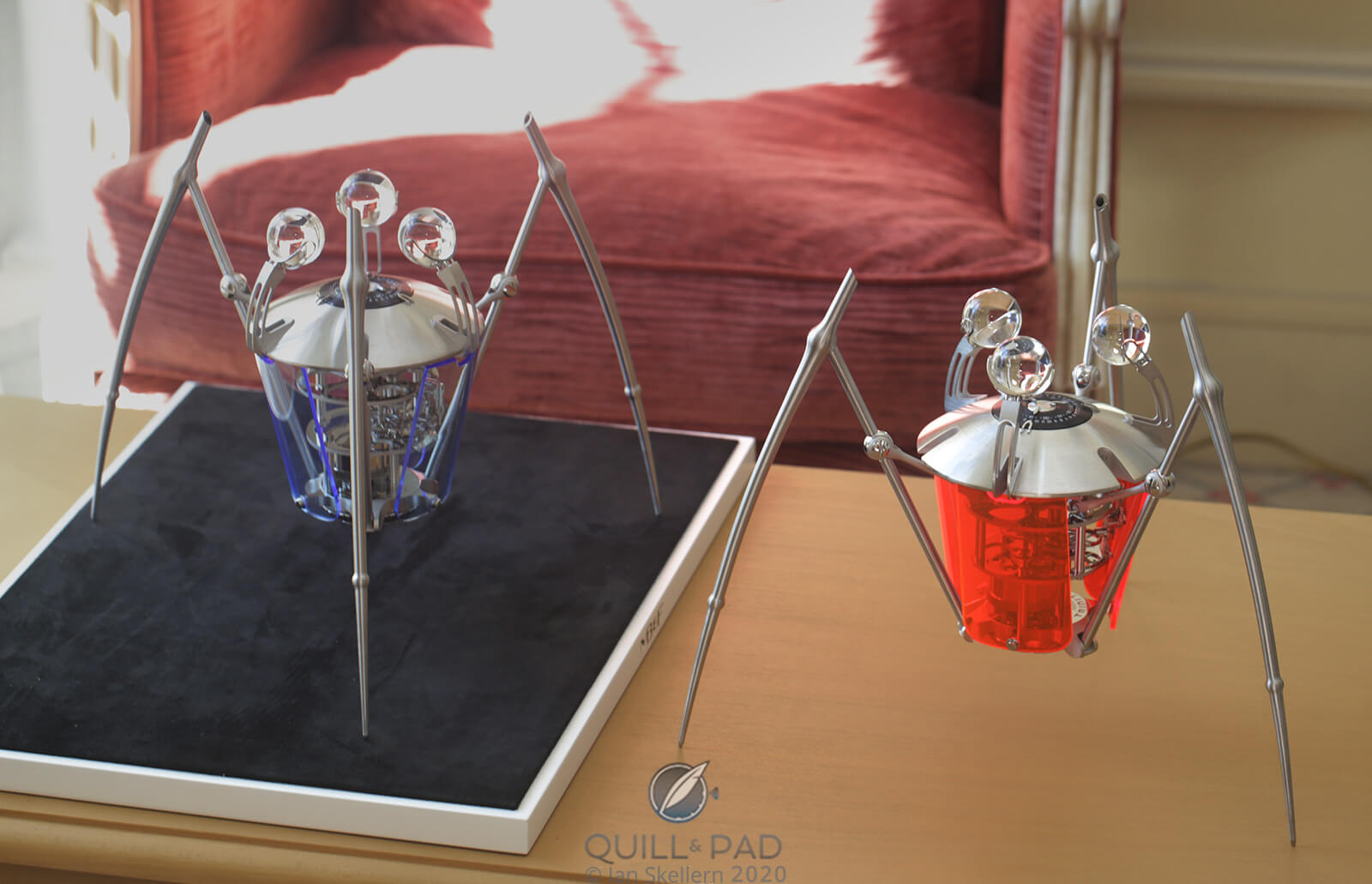
MB&F + L’Épée 1839 TriPod Blue and Red
At this point you might ask how TriPod belongs in line with T-Rex. After all, Jurassic Park was about dinosaurs. “This insect is the transition between dinosaur and what comes next because they’re all still here,” Maertens acknowledged to me in a FaceTime discussion – unfortunately, though, he did not reveal what comes next to cap the trilogy.
TriPod’s inspiration is the mosquito caught in amber that provides the DNA allowing Jurassic Park’s scientists to create new dinosaurs.
So much for the backstory. Does this clock really look like a mosquito? No, it doesn’t.
There is a reason for that as well (naturally): using another insect as inspiration for the clock’s frame allowed it to be more elegant and delicate-looking while maintaining the necessary engineering stability. Maertens chose the water strider (Gerridae), an insect that elegantly scoots along the surface of water with long, slender legs.
The water strider also has more than three legs – unlike TriPod – but Maertens took full poetic license as a designer to make an engaging product. “This is a direction I really like to go to even if it’s a sort of fight with the engineers to get something as fragile as possible while retaining stability. My main intention was to make it movable and to have some flexibility in the legs, but that wasn’t possible because of the stability of the clock,” Maertens told me.
“However, the legs should really show my intention that the entire object is just standing on three really small points.”
And, yes, despite the seeming fragility of the legs, they more than serve their purpose, forming a stable base for the bug’s body, which we come to next.
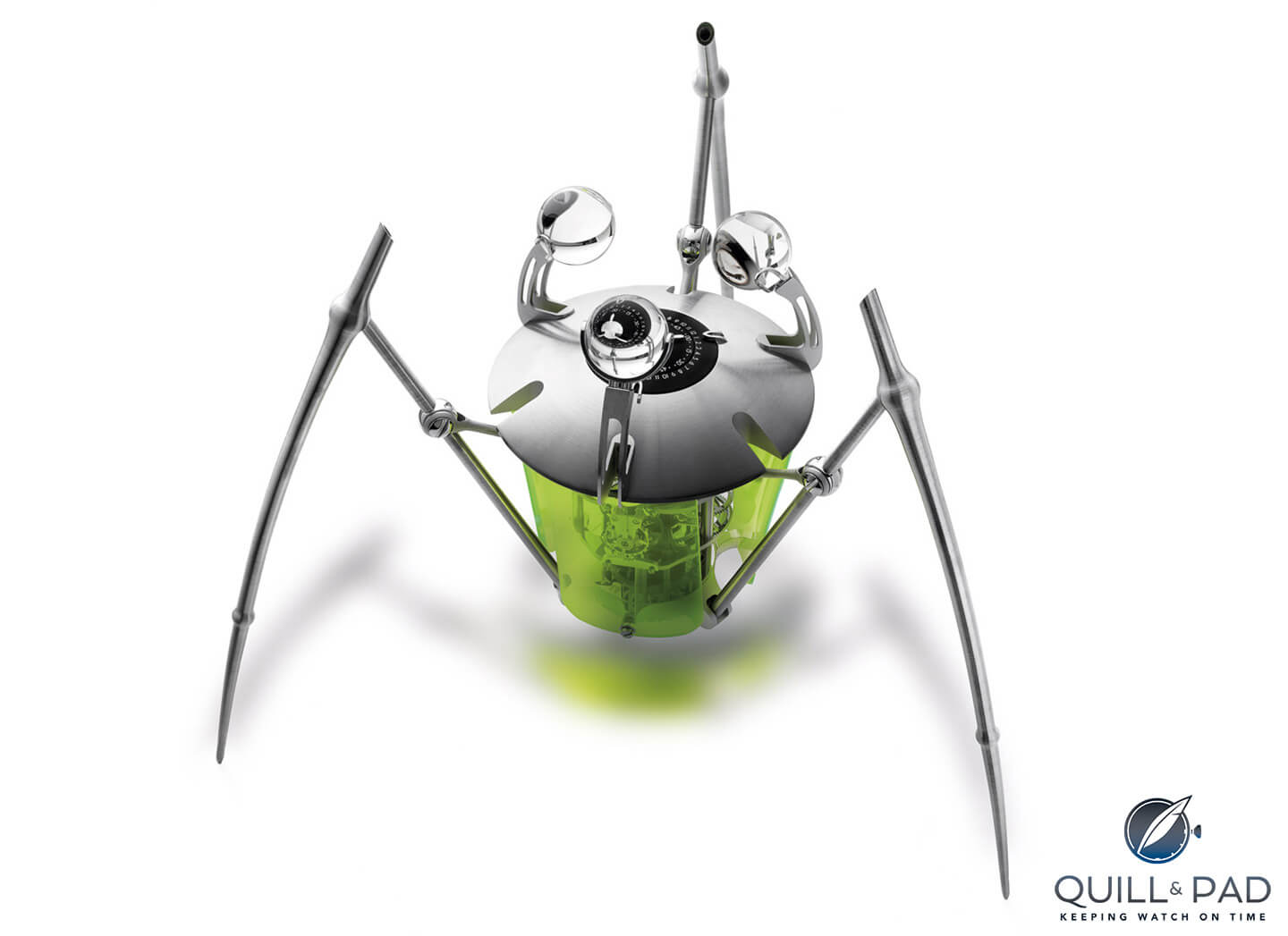
MB&F + L’Épée 1839 TriPod Green
TriPod’s body and what it houses
Talking to Büsser about TriPod over Zoom, I noted a certain light in his eye as he called these co-creations with L’Épée 1839 “Robocreatures.” He asked me if I had a better word for them, but truthfully I could not think of one and adapted the fun term into my own vocabulary immediately.
They, as he noted, do seem a bit like pets for the entrenched horophile. At the very least like companions. (But I suppose if I can look at my Atmos and think the same thing, I might very well have the same sort of screw loose, right?)
TriPod’s 26 cm plated brass body feels surprisingly more solid than it looks, coming in at 2.6 kilograms with its mass evenly distributed across those three slender legs.
It is sculptural and elegant, but it also serves another function: it houses the L’Épée 1839 movement that the Swiss clock brand’s designers specially re-engineered to serve TriPod. And that movement is visible thanks to the protective cast acrylic shields that Maertens called chitin as he talked to me, referring to the exoskeleton of an insect.
These shields are fluorescent and come in three different colors – incidentally, but not coincidentally, the same three that T-Rex’s Murano glass crystal is available in – blue, green, and red. Cast acrylic has the advantage of not shattering if damaged, having excellent optical clarity, and allowing the addition of fluorescence, which is really cool looking and light-reflective in low-light conditions.
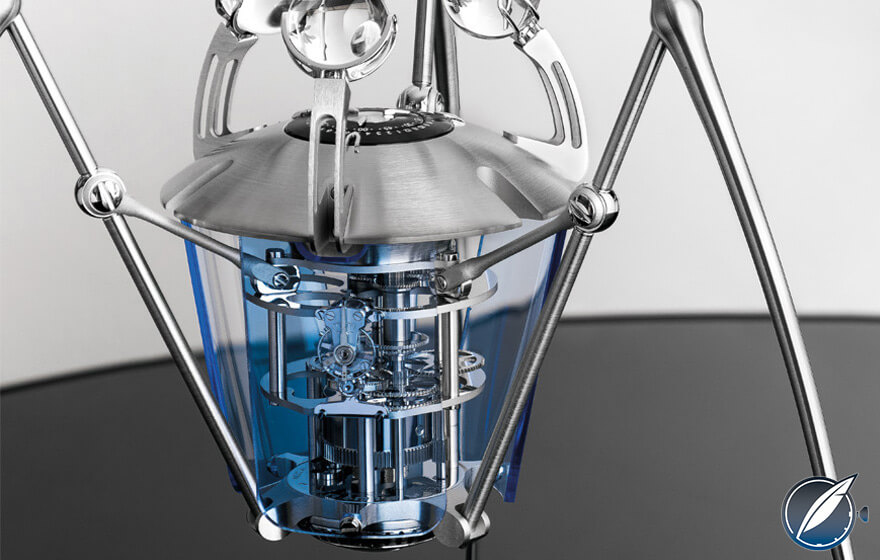
MB&F + L’Épée 1839 TriPod movement
The shields allow a pretty complete view of the excellent L’Épée 1839 movement built on three levels as well. The Swiss engineers re-designed it with four plates to create three distinct areas inside the movement. And, yes, L’Épée did this specifically to retain the “TriPod” theme.
“It would have been easier for us to have everything on one layer, but I am really picky: I like to go deep into details when we manufacture something. Even if it’s more complex, we don’t choose the more cost-effective or simpler way; we use the way that makes the most sense,” Arnaud Nicolas, CEO of L’Epée 1839, told me.
While the movement wasn’t 100 percent new, Nicolas explained to me that his team had to develop a new gear train to have modified energy transmission over the course of 36 hours instead of 12 hours. The team had to also calculate the ratio of the reduction gears differently to accommodate this.
The placement of the movement mimics an insect torso, while the balance forms its beating heart. It’s a very clever design on every front.
Displaying the time: optics matter
The most challenging part of TriPod was the time display as Maertens had a specific idea for it that Nicolas had to turn into reality. Thanks to his master’s degree in optics, the engineer was able to elegantly solve this puzzle.
The time is displayed by two concentric, rotating disks. The outer one displays three sets of hours while the inner one indicates the minutes in increments of 15 three times. The time can be easily read from any angle thanks to three optical spheres magnifying the clock’s numerals and even turning them upside down. Nicolas points to this as being the most difficult hurdle of the entire clock.
These three spheres are obvious “insect eyes” and are supremely functional at showing the time from any angle.
The dial’s hour disk features three sets of numerals 1-12, meaning that the dial completes a full rotation in 36 hours instead of the customary 12. The time is visible through the magnifying lenses at any time and from any angle.
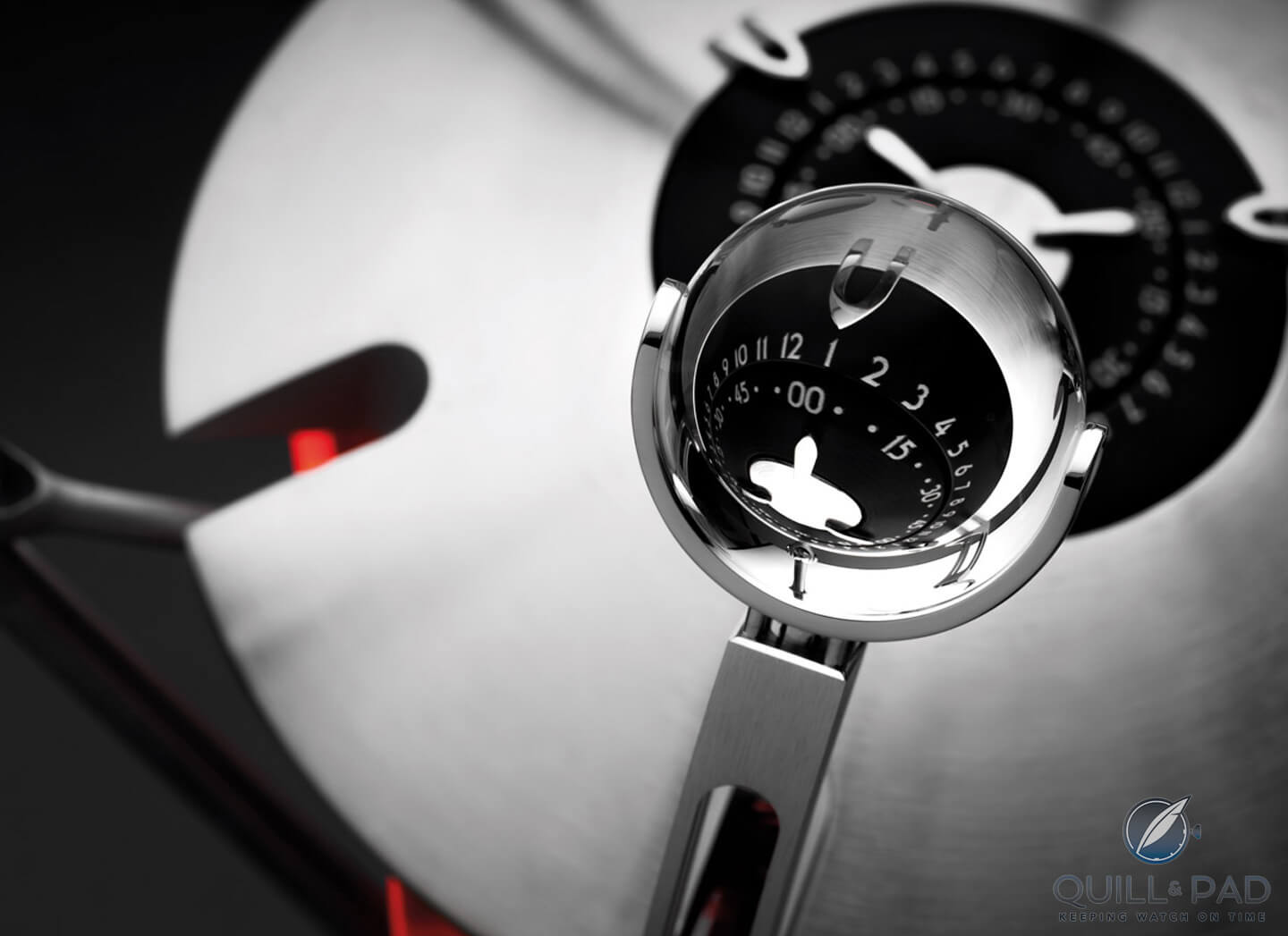
Looking through one of the three spherical lenses of the MB&F + L’Épée 1839 TriPod
To achieve the desired effect, the precision of the glass spheres had to have the tolerance of an optical lens, and the optimal distance between sphere and dial needed to be perfectly calculated. Additionally, Nicolas needed to calculate the perfect size for the spheres themselves.
The proportions, the right magnification, and the right distances were essential to the success of the clock’s unusual display. And to get that, the shape of the spheres had to be made within a ten-micron tolerance; even the tiniest bit of misalignment would change the magnification, potentially making the time indications blurry.
“The three spheres all indicate the same time,” Nicolas explained. “But to have an accurate view of it, you had to make sure the precision of the sphere was very precise. In fact, it’s not common to have a ball shape with the tolerance of a lens. The size of the sphere needed to be nice enough that you can really see it, but not not too big that it would change the design.”
The spheres are manufactured by a lens maker who makes lenses for aerospace use. Nicolas was adamant they have absolutely no impurities, that they be perfect spheres “without a scratch or anything, which is not common in watchmaking.” TriPod’s lenses are made utilizing the exact same processes used to make telescope lenses.
The next problem was how to hold TriPod’s spheres in place. I asked if Nicolas and his team thought to “set” them like a diamond. “If you do that with glass, then you scratch the glass because it is not as hard as a diamond. So, we wanted to use this kind of holding system . . . that would curve and catch it like a hand.”
The result was three one-piece “arms” that suspend the spheres, cradling them not to disturb their shapes or functionality. Or scratch them. Extreme engineering.
The result of the trio of creative professionals’ hard work is a wondrous piece of art that also tells the time.
“We love to work with Max because we trust each other, and we know that when we do something it will be nicely made by both. And in time. Nicely made and in time,” Nicolas laughed as he talked about his relationship as a “friend” of MB&F. “That’s what makes our projects, our partnership, so successful: we trust each other.”
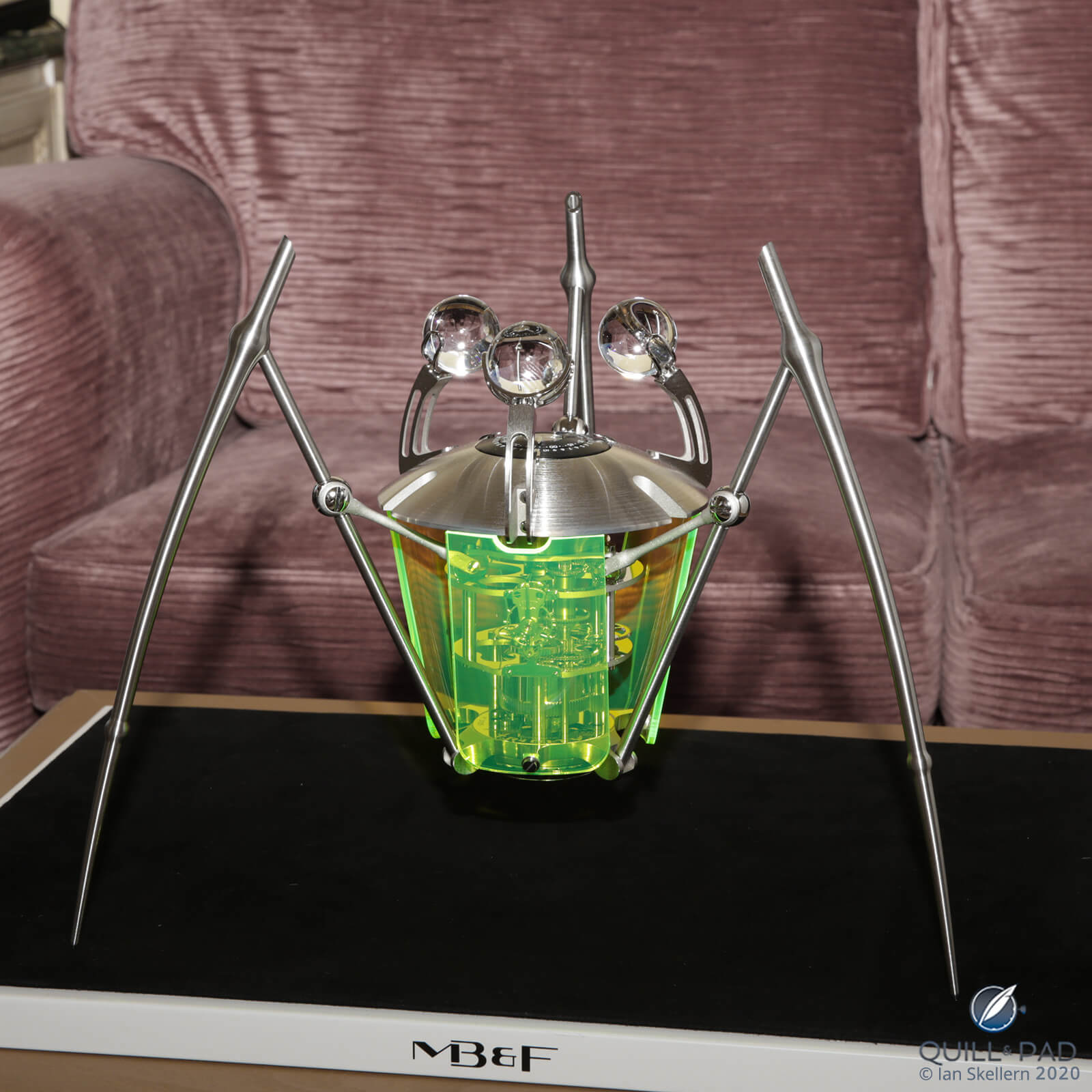
MB&F + L’Épée 1839 TriPod Green
Maertens, who also independently designs furniture and light fixtures, is likewise fully enamored of working with the Swiss independent. “MB&F for me is a love story. I mean the opportunity to do the stuff I can do there, nobody else would do it. Nobody else is as positively crazy as Max. I know that most of my pieces are a little bit too extroverted and too crazy for others, and he always got the crazy part of the idea – and if it’s a good idea he liked it.”
For more information please visit www.mbandf.com/en/machines/co-creations/tripod.
Quick Facts MB&F + L’Epée 1839 TriPod
Functions: hours and minutes
Casing: plated brass, optical mineral glass, and fluorescent acrylic shields, 26 cm height, 34 cm diameter, 2.6 kg weight
Movement: manual winding L’Epée 1839 in-house designed and manufactured, 18,000 vph/2.5 Hz frequency, one barrel, power reserve eight days
Limitation: 50 pieces each with blue, green, or red shields
Price:
You may also enjoy:
MB&F, L’Épée 1839, Massena Lab’s T-Rex Bronze: The Missing Link
Will These Unique Timepieces Be Only Watch 2019’s Top Performers?
Complete Listing And Live Photos Of All 50 Timepieces In The 2019 Only Watch Charity Auction





















































Leave a Reply
Want to join the discussion?Feel free to contribute!